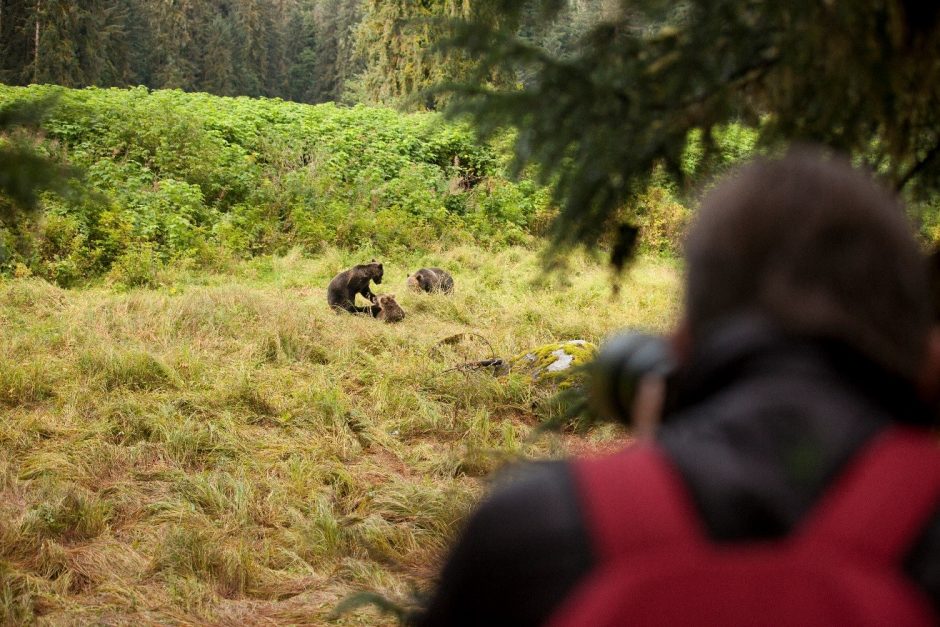
3 Tips for Photographing Bears at Close Range
It’s getting to be that time of year – the flowers are starting to bloom, birds are starting to sing, and brown bear photo expeditions are coming up! To make sure you are ready, whether it’s bears on a specially designed photo trip or right in your backyard, here are a few tips to help you make the most of your photos.
1) Take wider shots than you think you should
Filling the frame with a massive bear head is fantastic, and definitely something that you want to photograph if you get the opportunity. However, many photographers will use telephoto lenses excessively, such that they only have the bear in the shot – not much of the environment, background, or anything else. While it’s alluring and fulfilling to see your shot on the screen of your camera and marvel at how close you were able to get, and the detail of the fur still wet from the grasses it just tromped through… this is only part of the story. What about showing your fellow travelers in the shot, or the style in which you are viewing the bears (were you on a trail, did you have chairs or a platform that you were viewing from?). Story telling is a key part in photography, but not just for the sake of “documenting” the shot. Be artistic, use creative angles and compositions to get this storytelling shot to be a work of art. Be deliberate in what you include and what you don’t. And maybe you don’t even get a shot of the bears at all, but when shown side by side that photo of you on the trail, it becomes much more evocative when you see the next photo in your portfolio with the bears in perfect view.
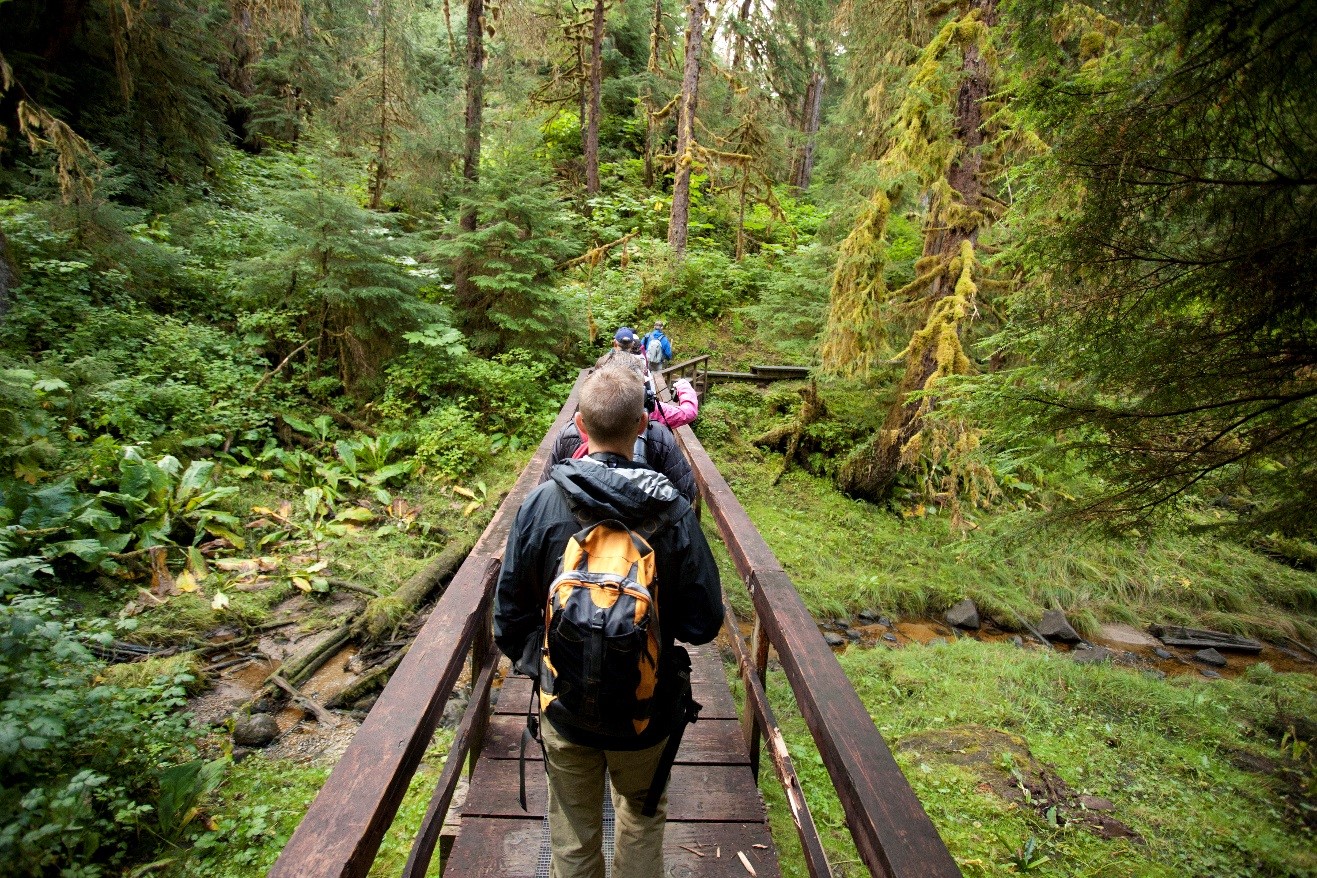
2) If you’re going to fill the frame, make sure you have a wide depth of field (high f/stop number).
Depth of field, as it pertains to your aperture/f-stop number, is a funny animal. It actually has a great deal to do with the amount of the frame you fill with the subject. That is, if you photograph a bear from far away, you don’t actually need that much depth of field, for if you focus on the bear the entire bear will be in great focus. However, as you fill the frame with the bear, it becomes critical to increase the depth of field by dialing in a higher aperture number to account for the bear taking up more and more of the entire frame. While a bear photographed 100 yards away can be in complete focus at f/4, a bear at 10 yards away needs to be photographed with a much higher aperture number…f/8 or greater.
The second of these photos is a bear further away, using f/4. The first, which is obviously much closer, is at f/11.
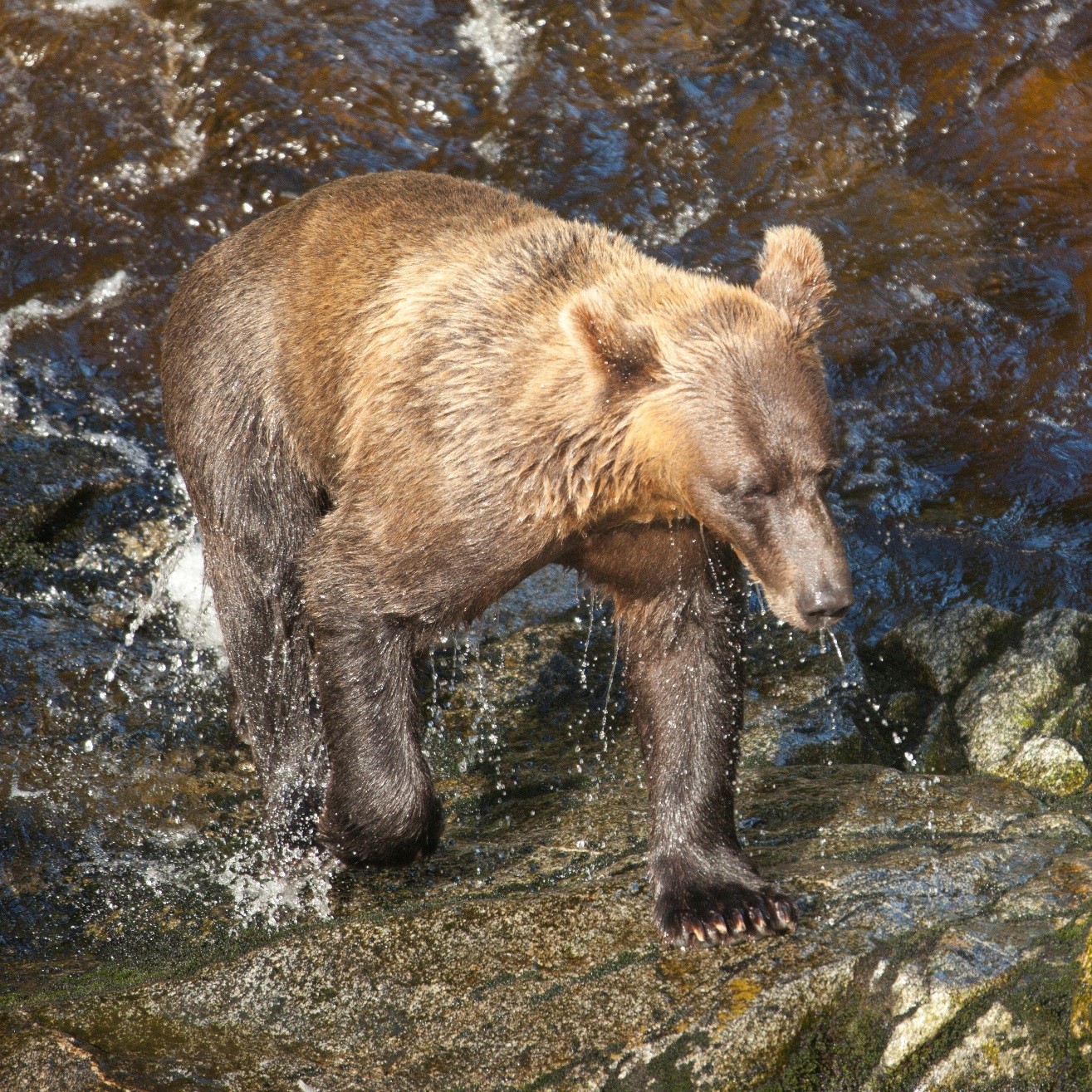
Notice how the bear above is very crisp, from the nose to the tail. If you had shot it at f/4, only the area around which you physically focused your camera would be sharp – those parts closer or farther would be blurry.
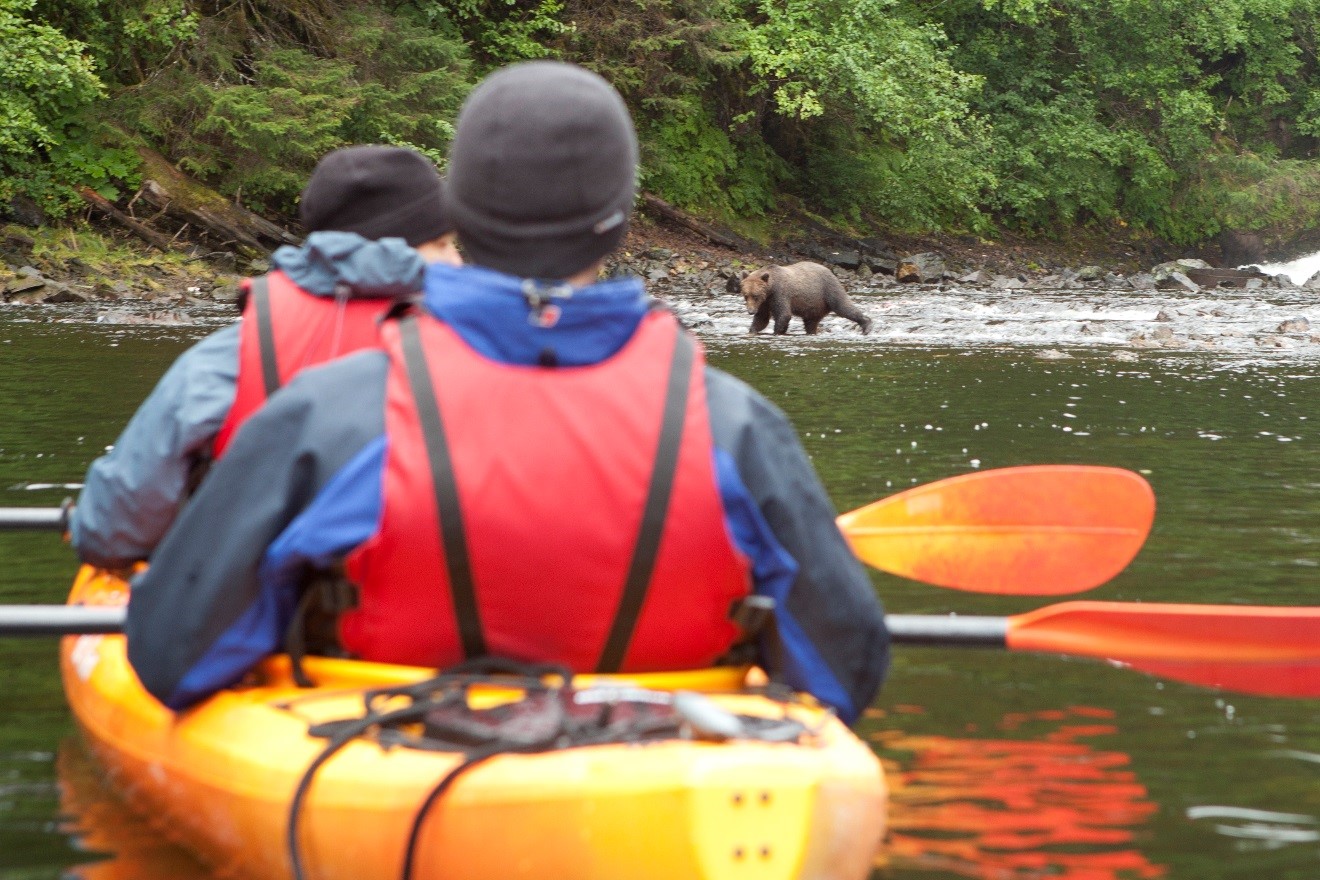
See here that the bear in the distance is actually quite sharp, even though photographed at f/4. However, everything in the foreground (the kayakers) is blurry. This blur produces a pleasing and artistic effect. It also directs the attention of the viewer towards the sharper, more focused areas, of the scene — the brown bear on the rushing river.
Shoot lots of photos
What a no-brainer, right? Well, rest assured if you have the remarkable chance to photograph grizzlies in the wild, you will at some point think to yourself “wow, I already have 1,000 photos of this grizzly rolling around in the grasses, or chasing after salmon…I probably have taken as much as I need of this guy…”. Don’t stop now! You’d be surprised how often I come back from a trip and my favorite action photo is the 1,001th shot of the same thing.
It’s difficult to say whether it’s luck, or perhaps my eye is getting used to the spectacle, and my nerves are calming, allowing me to see it in a different way. Either way, I consistently notice that when I stay involved and continue firing away, I capture something special. It could be a particular behavior, a unique angle, or some brilliant lighting. Now, don’t get me wrong, I think it does us all good to put the camera down sometimes and just soak it all in without having to capture it on film, but I’m just saying that with big charismatic megafauna, the more the merrier when it comes to taking home photos.
If you are fortunate enough to be headed on a photo trip to Alaska this summer, we wish you the very best and hope these tips prove to be useful!
Go forth and give it a shot,
10 Comments

Arddyn Moolman
April 6, 2018 at 7:46 am
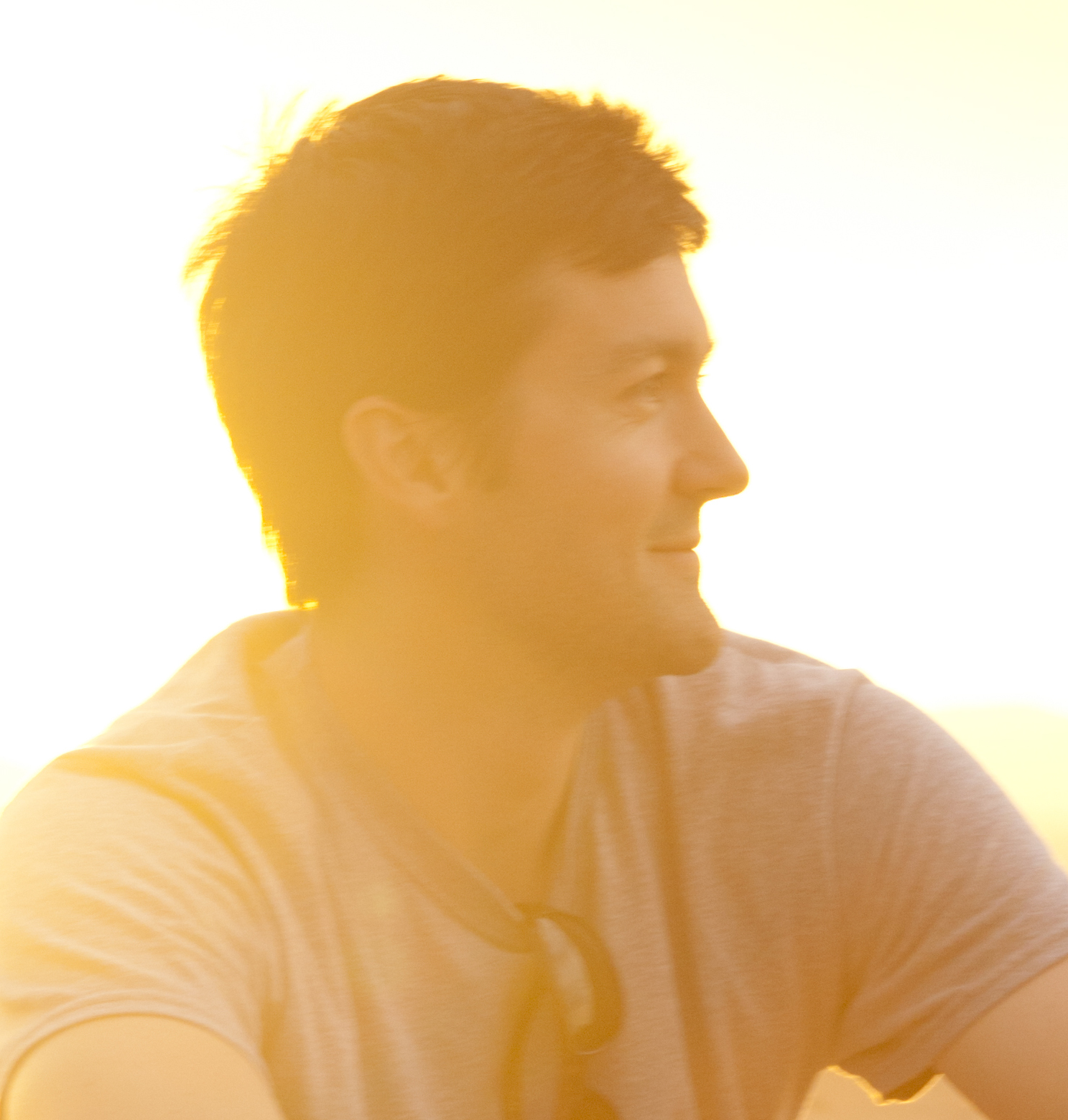
Court Whelan, Ph.D.
May 5, 2018 at 3:27 pm

vivek
June 26, 2018 at 9:24 pm

Court Whelan, Ph.D.
July 9, 2018 at 1:03 pm

Jay Hull
January 24, 2019 at 5:17 pm

Court Whelan, Ph.D.
February 3, 2019 at 1:39 pm

Michelle
April 18, 2019 at 7:44 am

Court Whelan, Ph.D.
April 30, 2019 at 12:03 pm

Carol K Escher
July 28, 2021 at 9:27 am

Court Whelan, Ph.D.
August 6, 2021 at 12:37 pm
Hi Court……I will be going on a Alaska Grizzly Bear photo trip at the end of July with NatHab.
I just wanted to ask your opinion on the lenses I should take + cameras.
I have 2 x Canon 7D as I like to take both so I can use 1 lens on each at the same time.
The lenses I have are the following:
Canon 10-24
Canon 24-70 / 2.8
Canon 18-200 / 3.5
Canon 70-200 IS II 2.8
Canon 300mm
Canon 100-400 old one 4.5
What should I take and what can I leave behind?
Also I have both a tri-pod and a mono-pod. Should I take both?
Should I take a 2 x extender for the 300mm (or even for the 70-200?
Thank you for your assistance. Best regards Arddyn Moolman (Ms)
Hey Arddyn, sorry for the delay but I’ve been traveling! You’ve got a great kit, and all very helpful. Personally, I’d pare this back a little and leave the 18-200 behind, as well as the 100-400. I love both these lenses, but given all the other great lenses you have, you’re going to want to use the 70-200 and 300mm as much as possible. And yes, I’d bring the 2x for a few shots on the 300mm, too (even though you’ll probably use it just as often without the 2x as with). No need for the mono…just the tripod.
Hope this helps a little…if not, give me a call at 800-543-8917! Cheers!
Hi Court,
I came across this article while browsing information regarding Katmai national park bear photography. Apologies if my question is out of context here – I was wondering if Katmai national park allows the use of Tripods on their viewing decks ? I had done some reading and got some mixed information on the use of tripods in the park’s viewing decks.
Appreciate your replies.
regards,
Vivek
Hi Vivek! They used to, but reports from this current season is that they are not allowing fully extended tripods there any longer. I don’t really blame them, as it’s limited space in the first place. But, makes it harder to get that silky shot! When I return, I plan on bringing a small “gorillapod” that can be balanced on front of you on the platform, which is how I got this shot of the silky water. I think the main thing is that the park folks don’t want you to take up more than your space, so I don’t see why they’d complain about the minimalist gorillapod, as it definitely wouldn’t infringe on others’ viewing abilities. Good luck!
I was at Brooks Falls in Katmai this past summer (July 2018). I had only packed my tripod. On the Falls platform, the ranger insisted that I bring the legs of the tripod together and extend only one leg to form a monopod. At areas other than the Falls platform (e.g., the Riffles platform), they were fine with using it as an actual tripod.
Hi Jay, good comment here, and one that is very helpful to our readers. As places get more visitation, it’s always key to stay up to date on regulations, especially with tripods. More and more places are restricting them. However, as you say, it’s generally only in certain places where more people are around (to prevent accidents and/or crowding). And as you probably know, Riffles platform is still a sensational place for bear viewing and photography!
Hi Court, I wonder if you could advise. Apologies if these are daft questions.
I am coming on an Alaskan Bear Photography trip mid July this year and coming from the UK.
I have a Nikon D7200, with 10-20mm, 18-140mm and 70-300mm lenses planned to come with me as well as compact tripod, ( photographing and hiking in Yellowstone and Glacier the week before so think I need the lightweight wide angle). I have an old D80. Is it recommended to bring both bodies and would you say it was not necessary to bring a 150-600 sigma lens that I have used on safari before? Thinking of the weight overall but don’t want to miss opportunities for “the shot”!
Thank you.
Michelle
Hi Michelle, great questions here! Personally, I’m not sure if I would bring the second body, as it is indeed about 13 years old (technologically speaking), so you’re going to want to shoot on your newer 7200 anytime possible. I actually do think you’d enjoy bringing the 150-600. Thus, I’d leave the 2nd body at home and take the 150-600 in its place. If that’s STILL too much to bring (weight or space-wise), I might recommend leaving the 70-300 at home. With the 18-140 and 150-600 you’re really covering your range nicely. The only reason to bring the 70-300 is if you think it’s significantly better in quality than the 150-600. However, my guess is that it’s not, so maybe just simplify a little and leave that 70-300 at home?
Hi Court. Enjoyed your article. I am coming to Alaska the first week of September. I have a fly in at Lake Clark for bear watching. I have a Nikon D500 with Nikon 16-80 and a Tamron 100-400mm. I was advised to bring another camera body. I bought a Nikon coolPix P100. I have a mono/tripod. Do I need anything else?
Hi Carol, this all sounds great to me! The 100-400 will no doubt be your workhorse for bears. having the coolpix will help with landscape shots when you don’t have time to switch lenses. But I do suggest that you “resist” using the 100-400 for all your bear shots, as you’ll likely appreciate some of the wider shots of bears once you get them on a computer. They tend to be less showstopping when viewed on the back of your camera, but some of my favorite shots are the wider landscape shots with bears in them, rather than just all bear :). The only other thing I might suggest is a polarizing filter if you think you can get a shot of some of the salmon underwater as the bears trounce around…not an easy or widely available shot, but a really neat one if you get the chance!